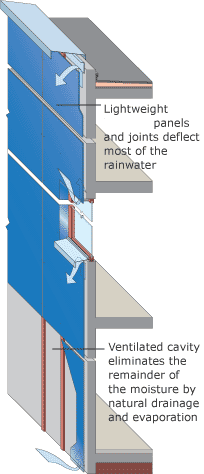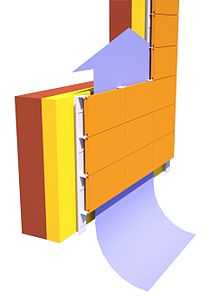Rainscreen cladding


Rainscreen cladding is a construction facade rainscreen system which consists of the subframe and different finishes like cladding panels, brick, ceramic tiles, reconstituted stone boards, ceramic granite based on a natural stone, high-pressure laminates, composite aluminium panels, metal panels (aluminum, zinc, steel), fibre-cement board, or durable exterior woods.
Rainscreen cladding is the attachment of an outer skin of rear-ventilated cladding to a new or existing building. The system is a form of double-wall construction that uses an outer layer to keep out the rain and an inner layer to provide thermal insulation, prevent excessive air leakage and carry wind loading. The outer layer breathes like a skin while the inner layer reduces energy losses. The structural frame of the building is kept absolutely dry, as water never reaches it or the thermal insulation. Evaporation and drainage in the cavity removes water that penetrates between panel joints. Water droplets are not driven through the panel joints or openings because the rainscreen principle means that wind pressure acting on the outer face of the panel is equalized in the cavity. Therefore, there is no significant pressure differential to drive the rain through joints. During extreme weather, a minimal amount of water may penetrate the outer cladding. This, however, will run as droplets down the back of the cladding sheets and be dissipated through evaporation and drainage.
By insulating the structural wall externally the following benefits are achieved:
- Thermal bridging is somewhat reduced because there are no interruptions caused by floor slabs, however vast thermal bridging is more than likely introduced by means of continuous furring strips. Options do exist to help reduce the amount of thermal bridging introduced or even eliminate the thermal bridging altogether by truly insulating continually across ALL structural members with not breaks or bridges in the insulation except for the finite fasteners used to attach the cladding to the building (negligible by ASHRAE 90.1 standards since their thermal bridging effect is so slight)
- Temperature fluctuations are minimized due the achievement of higher effective R-values (lower U-Values) therefore creating a much more efficient wall assembly and dramatically reducing the loads on HVAC systems.
- Interstitial condensation is prevented as vapor pressure and wall temperature restricts condensation to the ventilated cavity.
- Heat from the sun is dissipated so that the temperature is dispersed in the cavity and ventilated through openings.
See also
- Double-skin facade
- Rainscreen
- Rainscreen drainage plane
- Cladding (disambiguation)
External links
| Wikimedia Commons has media related to Rainscreen cladding. |